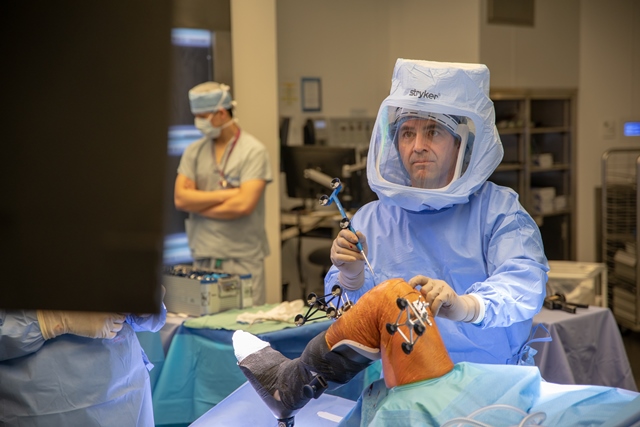By Maria Hayes
It was agile, confident strides that led Peter Sporta into the fracture clinic exam room at St. Joseph’s Healthcare Hamilton. The 66 year old Oakville resident showed no signs of having a partial knee replacement only 32 days earlier.
“It’s incredible! To think I was in such pain for two years,” says Sporta, “and within three days of the surgery I was walking without a cane or crutches.”
His satisfaction is an important marker for his surgical team. The truth is one in five orthopedic patients are unhappy with their knee surgery.
“The complaint we hear is ‘it doesn’t feel like my knee,’” says Dr. Anthony Adili, Orthopedic Surgeon and Chief of Surgery at St. Joseph’s.
Adili and his team hope to change that statistic, by using the MAKO Robotic System for orthopedic surgeries. St. Joe’s in Hamilton has already embraced the world of robotics, using the da Vinci system for thoracic and prostate surgeries for more than a decade. Now it is the first hospital in Canada to add robotics to its joint replacement practice. The two million dollar investment was made from philanthropic donations to St. Joseph’s Healthcare Foundation.
The device is a robotic arm that is guided by the surgeon. The significant advantage it provides happens in two stages: first in preparation, it allows the surgeon to plan the exact location and measurements of the knee implant on a computer in 3D. The second advantage is in execution, the MAKO prevents the surgeon from unintentionally cutting beyond the parametres created in the plan, significantly enhancing the precision of the surgery.
The exactness of the robotic arm is a game changer for patients like Peter. Only part of Sporta’s knee was damaged but he was initially scheduled for a full knee replacement by traditional methods. Then his doctor offered another option. A partial knee replacement in Hamilton by Adili and a robot.
“At first I thought, oh no way,” Sporta says with a laugh. Then he did a little investigating online and was curious. He met with Adili and the Hamilton team and felt overwhelming reassurance. “They said recovery should be quicker. I’m happy with that.”
Partial knee replacements done by traditional surgery have a bad track record according to Adili.
“Partial knee replacements fail at a very early age, at a very high rate because the alignment is not good,” says Adili. “That’s why most people do total knee replacements rather than partial, because the outcomes are much more reliable.”
It’s hoped robotic surgery will change that. “This technology allows us to do a partial replacement with near exact alignment,” adds Adili, “We can leave the good the parts of the knee intact and just address the damaged part.”
Along with quicker recovery, it’s expected patient satisfaction will also improve. “By leaving as much of the patient’s normal anatomy untouched, we think they will have a more ‘normal’ feeling knee, better outcomes and better range of motion,” says Adili.
It’s certainly been the case for Peter Sporta. Although he feels what he describes as a ‘numbness’ where the implant lies beneath his skin, he is more than pleased with how strong his knee feels, and how well he can move.
“I really want to get back to playing tennis,” he adds.
“Go ahead,” says Adili, “just don’t go full out right off the bat.”
Matching Peter’s enthusiasm is the ultimate goal for Adili and the orthopedic team.
“We really want a knee, where the patient has a surgery but they don’t feel like they’ve had a surgery.”
Maria Hayes works in communications at St. Joseph’s Healthcare Hamilton.




